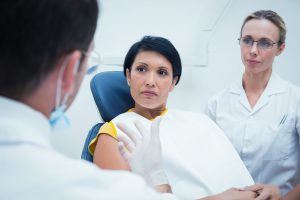
As a dental hygienist in Minnesota, I complete a professional portfolio to maintain my license. One of the core competencies is Patient Communication. As healthcare professionals we guide patients to better health through communicating therapy needs, providing the latest education and motivating patient self-care. Salivary diagnostics allows the clinician to have an objective measurement provided by a credentialed clinical laboratory. However, before the clinician and patient can benefit from these salivary test results, the patient must first accept testing services. In the following scenarios, I will pose frequently asked questions from OralDNA® Labs providers’ patients and their corresponding answers.
Scenario: Existing patient with active signs of periodontal disease. Recommendation of MyPerioPath® to determine bacterial risk/cause.
Patient: Why is this test important?
Healthcare Professional: In order to treat you the most effectively it will help to have an objective measurement of therapy. The results will allow me to form a personalized treatment plan. I can treat without the MyPerioPath® result, but I will not know the specific bacteria I am trying to combat. I could potentially be under-treating or over-treating your disease, and it may take longer to see resolve.
Scenario: New patient with Type II Diabetes has active signs of periodontal disease. Recommendation of MyPerioPath® to determine bacterial risk/cause.
Patient: How will having this result change my course of therapy?
Healthcare Professional: With the MyPerioPath® results, I can determine if there is a bacterial risk involved. If there is bacterial risk, I have many things I can do to address the levels of bacteria present. If it is not bacterial, then I will develop a treatment plan that may not include a systemic antibiotic or antimicrobials rinses. Also, if the tested pathogens are not the cause of your periodontal disease, we will know we need to explore other reasons for your inflammation. Perhaps further testing with Celsus One ™ may be needed to gain a better understanding of your genetic inflammatory risk. We may also want to explore your medical history and current control of your Type II Diabetes.
This is an interactive blog. Please feel free to share your insight and outline how you respond to your patients’ questions related to salivary diagnostic testing. We welcome your contribution! Have a case study to submit? Want to be featured as a guest author? What topics do you want to learn more about? Tell us: info@trendsinsalivarytesting.com. Remember, as healthcare professionals our mission is to have healthier patients and patient communication is essential to reach that goal.
For more information on how to become an OralDNA Provider – scan HERE: 
- The Winning Team: The Healthcare Provider & The Clinical Laboratory - April 12, 2024
- An Introduction to the History of Clinical Laboratory Testing - October 13, 2023
- AAOSH Hot Topics 2023: Don’t Be Left Out in the Cold—Attend!!! - January 13, 2023
